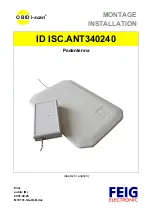
2 / 36
●
Under no circumstances install antennas in the vicinity of overhead power cables, otherwise the absolutely essen-
tial clearance requirements may no longer be satisfi ed. Maintain a clearance of at least 1 m from all other electrical
devices in all directions!
If you or metal parts of the antenna touch any electrical device there is a serious risk of a fatal electric shock!
●
Never work on antenna systems during a thunderstorm or when a thunderstorm is approaching.
There is a risk of a fatal electric shock!
●
Never install antennas on buildings with easily fl ammable roof coverings such as straw, reeds or similar materials!
Otherwise there is a risk of fi re due to atmospheric over-voltages (static charges) or lightning discharges
(e.g. during thunderstorms).
●
The installation operations described here assume good craftsmanship capabilities and knowledge of the behaviour
of materials under the eff ects of wind. Therefore if you do not possess the required skills, have this work performed
by a specialist.
●
The person doing the work must wear strong non-slip footwear, must not be liable to dizziness, must be able to
move around safely on the roof and have a secure standing and attachment position (if necessary, wear a safety
harness when on the roof).
●
Make sure that the roof is able to bear your weight. Never walk on fragile or unstable surfaces! In case of doubt,
contact a qualifi ed specialist dealer or specialist roofi ng contractor to fi nd an appropriate installation location.
●
Do not go on to roofs or other high places without a correctly attached safety harness that is in good condition.
Otherwise use a work platform.
●
Ladders or other means of climbing must be in faultless condition (dry, clean and non-slip). Never build any
irresponsible “scrambling towers”!
●
If there is a risk that passers-by may be injured by items falling from above during installation, you must close off
the risk area using barriers! Make sure that no-one is underneath the installation location.
Risk of death or injury due to falling from the roof, falling through the roof and falling parts, plus the
possibility of damage to the roof.
●
The respective national safety regulations and current standards such as DIN EN 60728-11 should be complied with.
●
Any other use or failure to comply with these instructions will result in voiding of warranty coverage.
Basic Safety Instructions
Before you install, connect or use the parabolic antenna,
make sure that you comply with the instructions in this manual
!
If you disregard these instructions,
●
malfunctions may arise, creating
risks
to your life and health,
●
defects in the installation or the connection may cause
damage
to the antenna or to the attachment point,
●
the manufacturer will
not accept liability
for malfunctions and damage arising!
When working on antenna systems, please remember your
duty of care towards your fellow human beings
!
Keep the manual for any questions that arise later, and if the building passes to another owner, pass it on to the new owner!
Selecting the Installation Site
It is essential to select the correct installation site. This determines whether your parabolic antenna can be erected safely and per-
form to its optimum capabilities.
When selecting the installation site, take account of special features of the structure of the building. If the installation is at the edge
of the roof or the building or on a cylindrical structure, DIN 1055, parts 4 and 4131 specifi es the increased wind and vibration loadings
that should be allowed for. The dynamic properties of the antenna and the structure can mutually infl uence each other and cause
detrimental changes.
When installing (e.g. under eaves), due to the off set angle of the antenna, there must be a clear view to the satellite at an angle of
approx. 60° above the top edge of the refl ector in relation to the horizontal.
Disregarding these considerations can lead to the maximum load or vibration fatigue stress listed in the Technical Data being excee-
ded.
The parabolic antenna need not necessarily be mounted on the roof
, since the requirement is not height as such but an
unobstructed “view” of the satellite. For this reason, an appropriate installation site might also be found for instance in the garden, on
the terrace, on the face of the building or on a garage.
In fact if other sites are possible, it is better to avoid the roof.
This will result in less work for you and will reduce the hazards asso-
ciated with installation work on the roof!



































